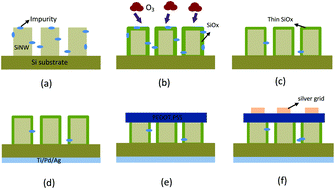High efficiency silicon nanowire/organic hybrid solar cells with two-step surface treatment†
Abstract
A simple two-step surface treatment process is proposed to boost the efficiency of silicon nanowire/PEDOT:PSS hybrid solar cells. The Si nanowires (SiNWs) are first subjected to a low temperature ozone treatment to form a surface sacrificial oxide, followed by a HF etching process to partially remove the oxide. TEM investigation demonstrates that a clean SiNW surface is achieved after the treatment, in contrast to untreated SiNWs that have Ag nanoparticles left on the surface from the metal-catalyzed etching process that is used to form the SiNWs. The cleaner SiNW surface achieved and the thin layer of residual SiO2 on the SiNWs have been found to improve the performance of the hybrid solar cells. Overall, the surface recombination of the hybrid SiNW solar cells is greatly suppressed, resulting in a remarkably improved open circuit voltage of 0.58 V. The power conversion efficiency has also increased from about 10% to 12.4%. The two-step surface treatment method is promising in enhancing the photovoltaic performance of the hybrid silicon solar cells, and can also be applied to other silicon nanostructure based solar cells.


 Please wait while we load your content...
Please wait while we load your content...